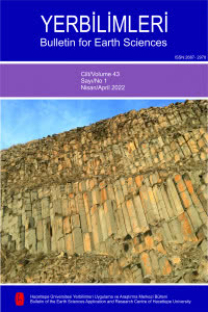Karadeniz' in İstanbul Boğazı çıkışı ile Zonguldak ve Amasra kıyı alanlarında güncel ostrakod topluluğu
Bu çalışmada, İstanbul Boğazı Karadeniz çıkışı ve doğuda Zonguldak-Amasra kıyı alanlarındaki bentik ostrakod topluluğunun, 0-110 m arası su derinliklerindeki dağılımı, 5 ayrı lokaliteden derlenen 19 grab örneğinde incelen-miştir. Toplam 25 cinse ait 39 tür saptanmış ve bu türlerin 23 adeti daha önce tanımlanmış olup, 16'sı ise isimlendirmeye açık olarak bırakılmıştır. Ostrakod topluluğu baskın olarak Marmara ve Ege Denizlerini de içine alan Akdeniz havzası ile benzerlik göstermekle birlikte, tür ve fert sayısı daha az bulunmuştur. Özellikle çalışma bölgesinin doğuda kalan alanlarında (Zonguldak, Amasra) tür ve fert sayısında dikkat çekici bir azalma gözlenmektedir. Karadeniz havzasına özgü endemik türler oldukça azdır. Saptanan ostrakodlar genellikle kumlu kil, kumlu şilt, çamur ile orta ve ince kum özelliğine sahip tabanı tercih etmektedir.
The recent ostracoda association of İstanbul Strait exit, and Zonguldak and Amasra coastal areas of Black Sea
In this study, bathimetric and horizontal distribution of benthic ostracod association from five subareas along the Istanbul strait exit, Zonguldak and Amasra coastal areas of Black Sea were examined on 19 grab samples taken from the 0-110 m depth. 39 ostracod species of 25 genera were determined of which 23 are known and 16 belonging to open nomenclature. The ostracod association is dominantly very similar with Mediterranean biofacies which included Sea of Marmara and Aegean Sea, but number of species and individuals are less than the areas given above. The number of species and individuals decreases specially at the eastern localities (Zonguldak and Amasra). In the study area Black Sea Basin endemic ostracodes are rare and ostracod assemblages generally prefer sandy clay, sandy silt, mud, medium and fine sand substrates character.
___
- Bonaduce, G., Ciampo, G., and Masoli, M., 1975.Distribution of Ostracoda in the Adriatic Sea. Publicazioni della Stazione Zoologica di Napoli, 40(1), 1-304.
- Eryılmaz, M., Türker, A. ve Aydın, Ş., 2002. Güneybatı Karadeniz (iğneada-lstanbul Boğazı-Kefken arası) güncel çökel dağılım haritası. 55. Türkiye Jeoloji Kurultayı, Bildiri Özleri Kitabı, 93, 94.
- Gülen, D., Kubanç, C. ve Altınsaçlı, S., 1995. izmit Körfezi (Hersek Burnu-Kaba Burun) Kuva-terner istifinin ostrakod faunası. izmit Körfezi Kuvaterner istifi, E. Meriç (ed.), Deniz Harp Okulu Komutanlığı Basımevi, 1531 71 .
- İslamoğlu, Y., Kapanyeşilyurt, S. ve Taner, G., 1996.Recent Molluscan fauna and their ecology of the Southern Part of the Marmara Sea (Turkey), Tübitak Ulusal Deniz Jeolojisi ve Jeofiziği Programı, Marmara Denizi Çalış-tayı, iTÜ Maden Fakültesi, Bildiriler, s. 6.
- Meriç, E., Avşar, N., Eryılmaz, M. ve Yücesoy-Eryılmaz, F., 2001. Güneybatı Karadeniz (Kilyos-İstanbul Boğazı kuzeyi-Riva-Domali-Kilimli ve Amasra) güncel bentik foraminifer topluluğu ve çökel dağılımı, Yerbilimleri (Geosound), 39, 155-183.
- Nazik, A., Meriç, E., and Avşar, N., 1996. Environmental interpretation of Quaternary sediments: Küçüksu Palace (Asiatic Side of the istanbul Bosphorus, Turkey). 3rd European Ostracodologist Meeting, Paris/Bier-ville, Book of Abstracts, p. 54.
- Olteanu, R., 1978. Ostracoda from DSDP LEG 42B.Initial Reports of the Deep sea Drilling Project, XLII, 2, sites 379-381, 1017-1038.
- Sissingh, W., 1972. Late Cenozoic Ostracoda of the South Aegean Island Arc. Utrect Micropa-leontological Bulletins, 6, Schotanus Publishing Company B.V., Ultrecht, Netherlands, 187 pp.
- Stancheva, M., 1989. Taxonomy and biostratigraphy of the Pleistocene ostracods of the western Black Sea Shelf. Geologica Balcanica, 19(6), 3-39.
- Tunoğlu, C., 1984. incipınarı-Kurtkuyusu (Sinop batısı) yöresi Neojen'inin Ostrakod biyostratigrafisi. Yüksek Mühendislik Tezi, Hacettepe Üniversitesi, Fen Bilimleri Enstitüsü, 173 s. (yayımlanmamış).
- Tunoğlu, C., 1999. Recent Ostracoda association in the Sea of Marmara, NW Turkey. Yerbilimleri, 21, 63-89.
- Tunoğlu, C., 2001a. New Pontian Tyrrhenocythere (Ostracoda) species from Araklı (Trabzon), Eastern Black sea region of Turkey. Yerbilimleri, 23,129-143.
- Tunoğlu, C., 2001b. Pontian aged Loxoconcha (Ostracoda) species from eastern Black Sea region of Turkey. Yerbilimleri, 24,127-142.
- Tunoğlu, C., 2002. A new Pontian Genus and Subgenus discovery of Candonidae (Ostracoda) from the Eastern Black Sea Region of Turkey, Türkiye Jeoloji Bülteni. 45(1), 99-111.
- Tunoğlu, C. ve Gökçen, N., 1985. İncipınarı-Kurtkuyusu ( Sinop Batısı) Üst Miyosen istifinde yeni Ostrakoda faunası. Yerbilimleri, 12, 1 9-39.
- Tunoğlu, C. ve Gökçen, N., 1991. İncipınarı-Kurtkuyusu (Sinop Batısı) Üst Miyosen istifinin ostrakoda biyostratigrafisi. Türkiye Jeoloji Bülteni, 34(1), 37-43.
- Tunoğlu, C., and Gökçen, N., 1995. Tethys and Para-tethys transition on the Black Sea Coast of Türkiye. EUG-8, European Union of Geosciences, Strasbourg, France, OS1 Paleontology, Stratigraphy and Sedimentology, Abstracts, p. 262.
- Tunoğlu, C., and Gökçen N., 1997. Pontian Ostracodes of the Sinop Area, Black Sea Coast of Turkey. Revue de Micropaléontologie, 40(4), 347-366.
- Tunoğlu, C., Ünal, A. ve Bilen, C., 1997. Doğu Karadeniz kıyısı boyunca Tetis-Paratetis geçişi ve etki alanlarının araştırılması. TÜBİTAK, Proje No: YDABÇAG-133, 149 s (yayımlanmamış).
- Uffenorde, H., 1972. Ökologie und jahreszeitliche Verteilung rezenter benthonischer Ostra-coden des Limski kanal bei Rovinj (nördliche Adria). Göttinger Arbeiten zur Geologie und Palaontologie, 13, 121 pp.
- Yassini, I., 1979. The littoral system ostracodes from the Bay of Bou-ismail, Algiers, Algeria. Revista Espanola de Micropaleontologia,11(3),353-416.
- ISSN: 1301-2894
- Yayın Aralığı: 3
- Başlangıç: 1976
- Yayıncı: Hacettepe Üniversitesi Yerbilimleri Uygulama ve Araştırma Merkezi
Sayıdaki Diğer Makaleler
CO2' ce zengin çorak, Karakaya ve Gümüşkent (Nevşehir) mineralli sularının hidrojeokimyası
